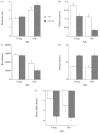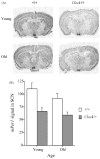Effects of age on circadian rhythms are similar in wild-type and heterozygous Clock mutant mice
- PMID: 15013573
- PMCID: PMC3760160
- DOI: 10.1016/j.neurobiolaging.2003.06.007
Effects of age on circadian rhythms are similar in wild-type and heterozygous Clock mutant mice
Abstract
The amplitudes of many circadian rhythms, at the behavioral, physiological, cellular, and biochemical levels, decrease with advanced age. Previous studies suggest that the amplitude of the central circadian pacemaker is decreased in old animals. Recently, it has been reported that expression of several circadian clock genes, including Clock, is lower in the master circadian pacemaker of old rodents. To test the hypothesis that decreased activity of a circadian clock gene renders animals more susceptible to the effects of aging, we analyzed the circadian rhythm of locomotor activity in young and old wild-type and heterozygous Clock mutant mice. We found that the effects of age and the Clock mutation were additive. These results indicate that age-related changes in circadian rhythmicity occur equally in wild-type and heterozygous Clock mutants, suggesting that the Clock mutation does not render mice more susceptible to the effects of age on the circadian pacemaker.
Figures




Similar articles
-
Vasopressin receptor V1a regulates circadian rhythms of locomotor activity and expression of clock-controlled genes in the suprachiasmatic nuclei.Am J Physiol Regul Integr Comp Physiol. 2009 Mar;296(3):R824-30. doi: 10.1152/ajpregu.90463.2008. Epub 2008 Dec 3. Am J Physiol Regul Integr Comp Physiol. 2009. PMID: 19052319 Free PMC article.
-
The mouse Clock mutation reduces circadian pacemaker amplitude and enhances efficacy of resetting stimuli and phase-response curve amplitude.Proc Natl Acad Sci U S A. 2006 Jun 13;103(24):9327-32. doi: 10.1073/pnas.0603601103. Epub 2006 Jun 5. Proc Natl Acad Sci U S A. 2006. PMID: 16754844 Free PMC article.
-
The circadian Clock mutation increases exploratory activity and escape-seeking behavior.Genes Brain Behav. 2003 Feb;2(1):11-9. doi: 10.1034/j.1601-183x.2003.00002.x. Genes Brain Behav. 2003. PMID: 12882315
-
The interrelations among feeding, circadian rhythms and ageing.Prog Neurobiol. 2007 Jun;82(3):142-50. doi: 10.1016/j.pneurobio.2007.03.002. Epub 2007 Mar 31. Prog Neurobiol. 2007. PMID: 17482337 Review.
-
Role for the Clock gene in bipolar disorder.Cold Spring Harb Symp Quant Biol. 2007;72:637-44. doi: 10.1101/sqb.2007.72.031. Cold Spring Harb Symp Quant Biol. 2007. PMID: 18419323 Review.
Cited by
-
Age-Related Changes in the Circadian System Unmasked by Constant Conditions.eNeuro. 2015 Sep 22;2(4):ENEURO.0064-15.2015. doi: 10.1523/ENEURO.0064-15.2015. eCollection 2015 Jul-Aug. eNeuro. 2015. PMID: 26464996 Free PMC article.
-
How Does Chronobiology Contribute to the Development of Diseases in Later Life.Clin Interv Aging. 2023 Apr 20;18:655-666. doi: 10.2147/CIA.S380436. eCollection 2023. Clin Interv Aging. 2023. PMID: 37101656 Free PMC article. Review.
-
The Effects of Constant Light and Running-Wheel Access in Middle-Aged Female C57BL6/J Mice.Sleep Sci. 2025 May 8;18(2):e201-e208. doi: 10.1055/s-0044-1791234. eCollection 2025 Jun. Sleep Sci. 2025. PMID: 40672892 Free PMC article.
-
Attenuated SIRT1 Activity Leads to PER2 Cytoplasmic Localization and Dampens the Amplitude of Bmal1 Promoter-Driven Circadian Oscillation.Front Neurosci. 2021 May 24;15:647589. doi: 10.3389/fnins.2021.647589. eCollection 2021. Front Neurosci. 2021. PMID: 34108855 Free PMC article.
-
Aging alters circadian regulation of redox in Drosophila.Front Genet. 2015 Mar 9;6:83. doi: 10.3389/fgene.2015.00083. eCollection 2015. Front Genet. 2015. PMID: 25806044 Free PMC article.
References
-
- Asai M, Yoshinobu Y, Kaneko S, Mori A, Nikaido T, Moriya T, et al. Circadian expression of Per gene mRNA expression in the suprachiasmatic nucleus, paraventricular nucleus, and pineal body of aged rats. J Neurosci Res. 2001;66:1133–9. - PubMed
-
- Aujard F, Herzog ED, Block GD. Circadian rhythms in firing rate of individual suprachiasmatic nucleus neurons from adult and middle-aged mice. Neuroscience. 2001;106:255–61. - PubMed
-
- Bae K, Jin X, Maywood ES, Hastings MH, Reppert SM, Weaver DR. Differential functions of mPer1, mPer2, and mPer3 in the SCN circadian clock. Neuron. 2001;30:525–36. - PubMed
-
- Batschelet E. Statistical methods for the analysis of problems in animal orientation and certain biological rhythms. Washington: American Institute of Biological Sciences; 1965.
-
- Czeisler CA, Duffy JF, Shanahan TL, Brown EN, Mitchell JF, Rimmer DW, et al. Stability, precision, and near-24-hour period of the human circadian pacemaker. Science. 1999;284:2177–81. - PubMed
Publication types
MeSH terms
Substances
Grants and funding
LinkOut - more resources
Full Text Sources
Medical
Molecular Biology Databases

